達(dá)芬奇:從科幻小說(shuō)里走來(lái)的機(jī)器人醫(yī)生
|
“天吶,,可別讓我絆著什么東西?!? 這是我小心翼翼地避過(guò)滿地的電線走進(jìn)手術(shù)室時(shí)的第一個(gè)想法,。這是十月初的一個(gè)早上,我在紐約長(zhǎng)島的猶太醫(yī)學(xué)中心,,穿著一件嬰兒式的藍(lán)色連體防護(hù)服,頭發(fā)和胡子都被捂得嚴(yán)嚴(yán)實(shí)實(shí)的,,嘴上戴著口罩,,鞋外面還戴了一層靴套,。 穿上這些東西,顯然不是為了方便,,而是為了保護(hù)那個(gè)躺在離我五尺外的手術(shù)臺(tái)上的病人,。他裸露的身體上已經(jīng)被醫(yī)生開了幾個(gè)小洞,那是癌癥專家詹姆斯·蘇利文醫(yī)生和他的團(tuán)隊(duì)用來(lái)插入醫(yī)療器械用的,。 然而這間手術(shù)室里除了蘇利文醫(yī)生之外還有另一位主刀醫(yī)師,,只不過(guò)這位醫(yī)生穿得比我們?nèi)魏稳硕际娣K闹醒氲鯒U和白色的手臂上戴著塑料的“袖套”,,這位醫(yī)生就是Intuitive Surgical公司的“達(dá)芬奇Xi”機(jī)器人手術(shù)系統(tǒng)了,。乍一看還真不好說(shuō)這里誰(shuí)說(shuō)了算。 深入病人體內(nèi)的儀器包括三個(gè)獨(dú)立可互換的部件,,它們可以切割,、移動(dòng)、抓握,、燒灼甚至操縱人體組織,。此外還有一個(gè)可移動(dòng)的高清攝像機(jī),它能以驚人的3D清晰度顯示病人體內(nèi)的情況,。蘇利文表示,,這種視覺上的優(yōu)勢(shì)已經(jīng)革命性地改變了醫(yī)生進(jìn)行微創(chuàng)手術(shù)的方式。現(xiàn)在醫(yī)生們已經(jīng)不需要把人開膛破肚來(lái)摘除某個(gè)組織或采集樣本了,。 |
“Oh, God, please don’t let me trip over anything.” That’s my first thought as I tiptoe around the electrical cords snaked across the operating room floor. It’s an early October morning at the Long Island Jewish Medical Center in New York. I’m decked out in a onesie-style baby blue protective suit, a hair mat, a bonnet to cover my beard, an additional mask for my mouth, and booties over my shoes. None of this is designed for agility. It’s meant to protect the patient lying on the table less than five feet away from me. His exposed torso is peppered with small holes through which cancer surgery specialist Dr. James Sullivan and his team insert their medical instruments. As it happens, there’s another surgeon in the room besides Sullivan—one more modestly garbed than either of us. Wrapped in plastic sleeves that cover its central boom and sprawling white arms is Intuitive Surgical’s da Vinci Xi robotic surgery system. It’s hard to tell who’s in charge. The instruments inside the patient include three separate, interchangeable components that can slice, shift, grasp, cauterize, or otherwise manipulate human tissue, as well as a movable high-definition camera that illuminates the body’s internal landscape in stunning 3D clarity. That’s a visual advantage that Sullivan says has revolutionized how doctors perform minimally invasive surgery—the kind that doesn’t require chopping someone open to remove a body part or collect samples. |

|
蘇利文走到手術(shù)臺(tái)左邊的控制臺(tái),,坐在了一個(gè)取景器前面。這個(gè)取景器很像某種具有未來(lái)主義色彩的游戲機(jī)的屏幕,。他用兩手的拇指和中指放到兩個(gè)移動(dòng)臂的圓環(huán)上,,控制臺(tái)的下面有幾個(gè)踏板,看起來(lái)有點(diǎn)像手動(dòng)檔汽車的離合器,。通過(guò)手指和腳的操作,,蘇利文就能控制這四個(gè)醫(yī)療器械在病人體內(nèi)的活動(dòng),并且可以在手術(shù)器械和3D內(nèi)窺攝像機(jī)間任意切換,。 接下來(lái)的幾個(gè)小時(shí),,他要使用達(dá)芬奇系統(tǒng)切掉病人的一個(gè)淋巴結(jié)進(jìn)行病理分析(這個(gè)病人患有淋巴癌)。 兩個(gè)小時(shí)后,,我問(wèn)蘇利文,,這個(gè)病人需要多久才能出院。 他反問(wèn)我:“你住在什么地方,?” “紐約布魯克林的布什維克,。”我答道,。 蘇利文笑了:“他可能比你先到家,?!? 科幻作品中歷來(lái)不乏機(jī)器人醫(yī)生的身影。雖然我們離“有病找安卓”的日子還有很遠(yuǎn),,但機(jī)器人參與手術(shù)卻已經(jīng)不是什么新鮮事了——當(dāng)然,,如果你不是外科醫(yī)生的話,或許會(huì)覺得挺震驚的,。加州森尼維爾市的Intuitive Surgical公司的機(jī)器人手術(shù)系統(tǒng)早在2000年就率先獲得了美國(guó)FDA的批準(zhǔn),,不過(guò)它的流行卻還是最近幾年的事。很多外科醫(yī)生表示,,該系統(tǒng)使他們能更清楚地看到病人體內(nèi)的情況,,同時(shí)也能對(duì)醫(yī)療器械進(jìn)行更好的控制。 Intuitive Surgical 的設(shè)備現(xiàn)在已經(jīng)廣泛應(yīng)用于美國(guó)所有的頂尖醫(yī)院中,,其應(yīng)用領(lǐng)域涵蓋了腫瘤科,、泌尿科、婦科,、消化科等等,,美國(guó)許多頂尖醫(yī)療機(jī)構(gòu)和院校,如紐約的紀(jì)念斯隆凱特琳癌癥中心,、梅奧診所,、約翰霍普金斯大學(xué)和克利蘭醫(yī)學(xué)中心等都采購(gòu)了該公司的機(jī)器人手術(shù)設(shè)備。截止到今年6月30日,,全球已有4100多臺(tái)達(dá)芬奇系統(tǒng)投入使用,,其中有2,703臺(tái)在美國(guó),698臺(tái)在歐洲,,538臺(tái)在亞洲,,還有210臺(tái)分布在世界其他地區(qū)。 |
Sullivan makes his way to a console on the left side of the OR, where he takes a seat in front of a viewfinder that looks like it belongs in a futuristic video game arcade. He places his middle fingers and thumbs into two pairs of rings on two movable arms. At the console’s floor are foot pedals, which function like a clutch in a manual car. With his fingers and feet, Sullivan will navigate the four instruments now inside the patient’s body—alternating between the pincer-laden surgical extensions and a 3D endoscopic camera. Over the next few hours, he’ll use the da Vinci to cut out a lymph node from the patient (who suffers from lymphoma) for lab testing. Two hours later, I ask Sullivan how long it will be before the patient is discharged from the hospital. “Where do you live?” he asks. “Bushwick, in Brooklyn,” I reply. Sullivan chuckles. “He’ll be home before you.” Futurist culture has no shortage of fever dreams starring robot doctors. This story isn’t about that. While we’re still a ways from the day when androids become our go-to physicians, robotic surgery is already commonplace—and probably surprisingly so, if you don’t happen to be a surgeon. Intuitive Surgical (ISRG, -0.51%) , headquartered in Sunnyvale, Calif., got the first-of-its-kind clearance for its robotic surgical system from the Food and Drug Administration back in 2000. But it has been largely in the past few years that its machines have exploded in popularity. Surgeons who tout the tech say it’s given them a far clearer view of what’s happening inside the body and greater control over their instruments. Intuitive’s devices are now used at all of the top-ranked U.S. hospitals for cancer, urology, gynecology, or gastroenterology—including venerable institutions like New York’s Memorial Sloan Kettering Cancer Center, the Mayo Clinic, Johns Hopkins, and the Cleveland Clinic. More than 4,100 da Vinci base units have been installed worldwide as of June 30, including 2,703 in the U.S., 698 in Europe, 538 in Asia, and 210 in the rest of the world. |
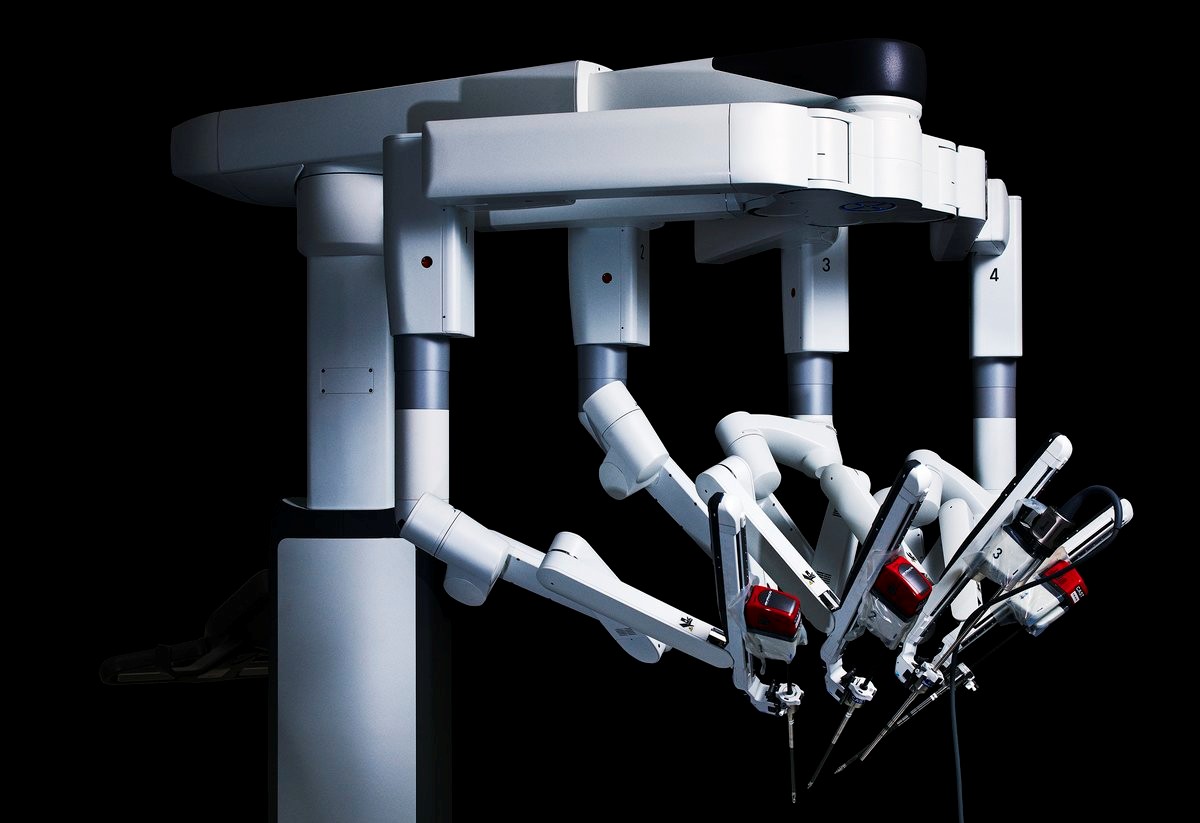
達(dá)芬奇手術(shù)機(jī)器人? 照片:Spencer Lowell為《財(cái)富》拍攝?
|
這樣一套系統(tǒng)可是不便宜的,,第四代達(dá)芬奇系統(tǒng)的單價(jià)是190萬(wàn)美元,,還不包括各種手術(shù)配件的費(fèi)用,這些配件的價(jià)格也高達(dá)數(shù)萬(wàn)美元,。盡管如此,,達(dá)芬奇系統(tǒng)的銷路依然火爆,越來(lái)越多的醫(yī)生都開始用它做手術(shù)了,。 公司的CEO加里·古塔爾特告訴《財(cái)富》記者,,自2000年以來(lái),達(dá)芬奇系統(tǒng)已經(jīng)完成了400余萬(wàn)例微創(chuàng)手術(shù),,全球每隔42秒鐘就會(huì)啟動(dòng)一臺(tái)由達(dá)芬奇系統(tǒng)主刀的手術(shù),。2016年,達(dá)芬奇系統(tǒng)在全球執(zhí)行的手術(shù)數(shù)量較上年增長(zhǎng)了15%,預(yù)計(jì)2017年還會(huì)在2016年的基礎(chǔ)上繼續(xù)增長(zhǎng)14%到15%,。對(duì)于某些較復(fù)雜的手術(shù),,比如前列腺?gòu)氐浊谐g(shù)等,由機(jī)器人輔助的手術(shù)已經(jīng)占到了手術(shù)總量的近90%,。 隨著機(jī)器人外科醫(yī)生的普及,2016年,,Intuitive Surgical公司的全球營(yíng)收入達(dá)到了27億美元,,其中有超過(guò)70%的銷量是自然形成的,這也突顯了該公司在這一快速增長(zhǎng)的市場(chǎng)上作為先行者的優(yōu)勢(shì),。 達(dá)芬奇系統(tǒng)的火爆也吸引了投資人的關(guān)注,。2017年,Intuitive Surgical公司的估值已經(jīng)暴漲了70%,,其市值已經(jīng)接近400億美元大關(guān),。 |
The systems aren’t cheap: The list price for the fourth-generation da Vinci Xi is $1.9 million, and that doesn’t include the cost of various surgical appendages, which can add tens of thousands of dollars more to the price tag. Still, the robots keep selling—and surgeons are increasingly adopting them in their practices. The company says that more than 4 million minimally invasive surgeries have been performed with da Vinci systems since 2000—a new one begins every 42 seconds somewhere around the globe, Intuitive CEO Gary Guthart tells Fortune. The number of those procedures done worldwide spiked 15% in 2016 compared with the previous year, and Intuitive pro?jects an additional 14% to 15% rise in the number by the end of 2017. Indeed, for certain more complicated procedures, such as radical prostate removal, robotic-assisted surgeries now account for nearly 90% of operations. The boom has driven Intuitive to $2.7 billion in 2016 global revenue, with more than 70% of sales being recurring in nature—a fact that underscores the advantage that comes from being the first major player in a rapidly growing market. That’s been a draw for investors too; in 2017 alone, Intuitive’s valuation has soared more than 70%, pushing its market capitalization near the $40 billion mark. |
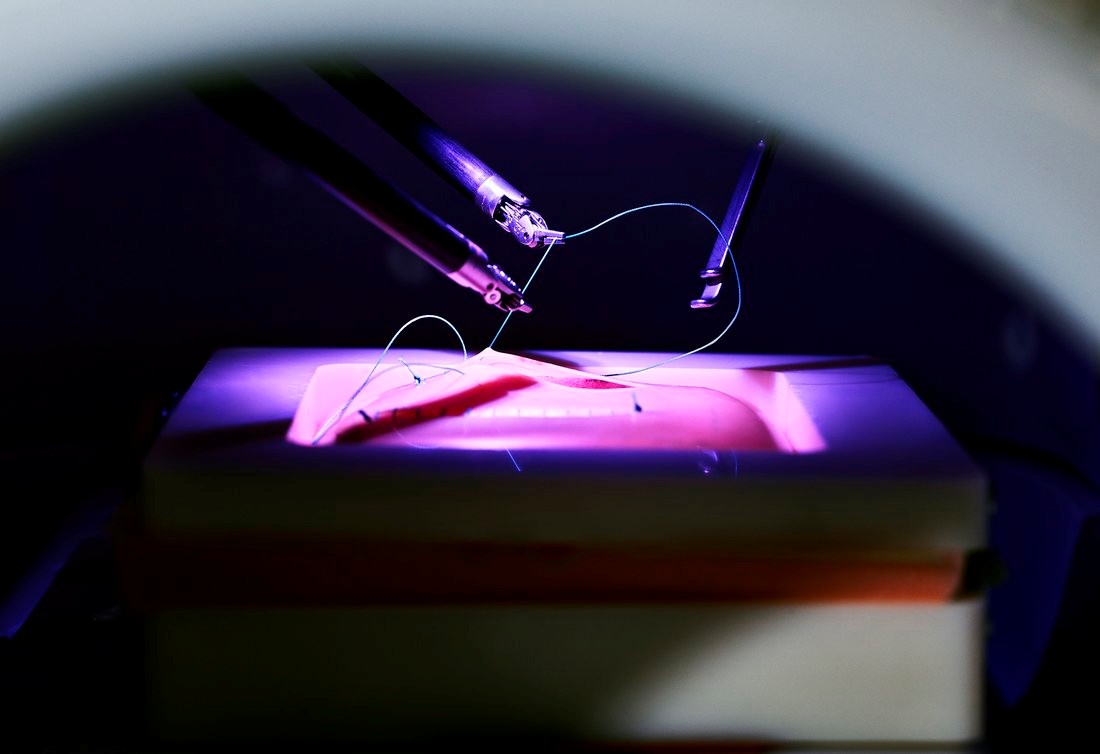
|
由于公司增長(zhǎng)速度太快,自然會(huì)有人擔(dān)心這種勢(shì)頭能否持續(xù)下去,。不過(guò)有些密切關(guān)注這家公司的人相信,,Intuitive Surgical的確把握了外科手術(shù)的未來(lái)發(fā)展方向。與此同時(shí),,這家公司也正在研制其他手術(shù)器械以進(jìn)行更多類型的手術(shù),,同時(shí)公司也在積極向亞洲擴(kuò)張,并且敢于主動(dòng)走出“舒適區(qū)”,,在癌癥診斷領(lǐng)域進(jìn)行探索,。 比如該公司已與中國(guó)的復(fù)興醫(yī)藥合資,探索在早期階段診斷肺癌,。他們開發(fā)了一種靈活的機(jī)器人導(dǎo)管,,可以進(jìn)入肺部的海綿狀區(qū)域進(jìn)行探查。已經(jīng)追蹤該公司達(dá)10年的摩根士丹利分析師大衛(wèi)·劉易斯指出:“目前在肺癌治療上的主要問(wèn)題是,,我們沒有很好的工具進(jìn)行診斷,。我們經(jīng)常不能及時(shí)發(fā)現(xiàn)肺癌,就是因?yàn)槲覀兒茈y將醫(yī)療器械探進(jìn)肺部,,同時(shí)又不對(duì)病人造成傷害,。” 劉易斯解釋道,,由于Intuitive Surgical的導(dǎo)管可以被精確追蹤定位,,因此可以更容易地識(shí)別出病灶?!拔覀冋J(rèn)為,,這種方法將徹底改革肺癌的治療方法?!? 馬丁·韋澤是紀(jì)念斯隆凱特琳癌癥中心的教育教學(xué)研發(fā)副主席兼主治醫(yī)生,,他表示:“有時(shí)候,,如果某個(gè)東西效果更好,你自然會(huì)知道,?!北热缜靶┠陜?nèi)窺鏡手術(shù)剛問(wèn)世時(shí)就是這樣。在進(jìn)行內(nèi)窺鏡檢查時(shí),,醫(yī)生要用手將醫(yī)療器械和內(nèi)窺鏡通過(guò)小孔探入病人體內(nèi),。不少醫(yī)生遲遲沒有學(xué)會(huì)這項(xiàng)新技術(shù),尤其是那些上了年紀(jì)的醫(yī)生,。不過(guò)最終,,內(nèi)窺鏡成了一種常見的手術(shù)方法。韋澤表示,,機(jī)器輔助手術(shù)系統(tǒng)也會(huì)像內(nèi)窺鏡一樣普及開來(lái),。“它既縮短了病人的住院時(shí)間,,也使醫(yī)生的手術(shù)過(guò)程更容易了,,所以你知道它是個(gè)更好的東西?!? 目前,,我們還不敢斷言機(jī)器人手術(shù)的質(zhì)量一定優(yōu)于人類醫(yī)生。我們也不要指望從現(xiàn)有的醫(yī)學(xué)文獻(xiàn)中找到答案,,因?yàn)楹芏嘌芯康慕Y(jié)論都是不統(tǒng)一的,。但是有很多醫(yī)生都愿意揮舞著他們的機(jī)器人手臂保證,同時(shí)他們對(duì)機(jī)器人系統(tǒng)也不乏溢美之辭,。比如很多醫(yī)生表示,,接受機(jī)器人手術(shù)的病人往往恢復(fù)得十分迅速,而以往他們接受傳統(tǒng)的開放式手術(shù)后,,往往要住院恢復(fù)幾天甚至幾個(gè)星期才能出院,。另外,攝像頭的“清晰性”和醫(yī)療器械的“靈活性”也讓很多醫(yī)生贊不絕口,。 |
The growth has been so breakneck that it’s natural to wonder if it can continue. But those who follow the company closely say they believe it can—that there is something truly intuitive about Intuitive’s grasp of the future of surgery. The company, meanwhile, is churning out new tools that can perform more kinds of operations, expanding feverishly into Asia, and experimenting well outside its comfort zone with cancer diagnostics. Intuitive has teamed up with China’s Fosun Pharma, for instance, in a joint venture to detect lung cancers in their earliest stages, developing a flexible robotic catheter that can navigate into the cavernous regions of the lungs. “The problem with lung cancer today is we don’t have great tools to diagnose it,” says Morgan Stanley analyst David Lewis, who has covered Intuitive for a decade. “We can’t always find it, because it’s hard to navigate something in the lung without doing damage to the patient.” Because Intuitive’s catheter can be tracked and targeted with pinpoint accuracy, it should make it easier to identify lesions with precision, Lewis explains. “We think this procedure will revolutionize the treatment of lung cancer,” Lewis says.?? “Sometimes, you just know when something’s better,” says Dr. Martin Weiser, an attending surgeon and a vice chair of education and faculty development at the Memorial Sloan Kettering Cancer Center, of robotic-assisted surgery. Such was the case when laparoscopic surgery debuted years ago. In laparoscopy, surgeons thread medical instruments and cameras by hand through small holes in the patient’s body. Surgeons, particularly older ones, were slow to adopt the new technology, largely because of the learning curve required. But eventually, it became common medical practice, says Weiser. The same has been true of robotic-assisted surgery, he says. “Whether it’s less time at the hospital for a patient or an easier time operating for a surgeon, you just know when it’s better.” It isn’t clear whether robotic surgery uniformly leads to better outcomes. (Don’t look to the extensive medical literature for a clear-cut answer; conclusions differ from study to study.) But surgeons who swear by their robotic arms tend to return to the same words of praise: They tout the “speed of recovery” for patients, who typically don’t need to spend days or weeks in a hospital as they might after traditional open surgery. They speak of the “clarity” of its camera, the “flexibility” of its instruments. |

一名Intuitive Surgical公司的工人正在組裝機(jī)械臂
照片:Spencer Lowell為《財(cái)富》拍攝?
|
當(dāng)我終于有機(jī)會(huì)親自上手測(cè)試達(dá)芬奇系統(tǒng)的訓(xùn)練模塊時(shí),,一開始的時(shí)候,“靈活性”這個(gè)詞當(dāng)然是談不上的,。不過(guò)在一個(gè)裝滿了氣球和硬幣等小玩意兒的假體上練習(xí)了幾分鐘之后,,我覺得我這雙天生不太協(xié)調(diào)的雙手似乎的確變得靈活了起來(lái)。不到十分鐘,,我就能操縱機(jī)器人在假人的胸腔里夾出一張5美元的紙幣,,并且把它遞給另一個(gè)機(jī)械臂,而且我的手腕只要輕輕一翻,就能將它翻個(gè)面,。(恰似蘇利文形容的那樣:“我好像長(zhǎng)了四只手一樣,。”)也就是這時(shí),,我才第一次注意到了那張5美元紙幣上的一些細(xì)節(jié),。紙幣的背面繪著林肯紀(jì)念堂,林肯紀(jì)念堂頂部寫著美國(guó)的26個(gè)州的名字,,由于這些字太小了,,我以前從來(lái)沒注意到過(guò)。不過(guò)在達(dá)芬奇系統(tǒng)的攝像頭下,,這些州的名字卻顯得十分清晰。 不過(guò)在醫(yī)學(xué)領(lǐng)域,,再牛掰的技術(shù),,如果不能讓詹姆斯(詹姆斯是蘇利文的一個(gè)結(jié)腸癌病人,今年42歲,,幾個(gè)月前,,蘇利文剛剛切除了他的部分大腸)這樣的病人切實(shí)受益,那也就跟耍雜技差不多,。詹姆斯一開始對(duì)機(jī)器人手術(shù)有些疑慮,,但在看了YouTube上的演示視頻后,他還是選擇了接受機(jī)器人手術(shù),?!拔矣X得它要么會(huì)做得非常完美,要么會(huì)非常糟糕,,”他說(shuō),。 手術(shù)后第4天,詹姆斯就出院了,。短短三周后,,他就返回了工作崗位。這與他父親15年前的遭遇簡(jiǎn)直是天壤之別——雖然理論上他們父子倆接受的是同樣的手術(shù),?!八麄兘o他從胸骨到恥骨來(lái)了個(gè)大開膛,把所有東西都拿了出來(lái),,最后再放回去,。所以他的恢復(fù)期要長(zhǎng)得多,花了好幾個(gè)月,?!? |
When I get the chance to test a da Vinci Xi training module myself, the word “flexibility” is the last one that would pop to mind. At first, anyway. But after a few minutes’ practice, “operating” on a plastic torso replica filled with balloons, pennies, and other knickknacks, even my own comically uncoordinated hands seem nimble, somehow. Within 10 minutes I was able to pick up a $5 bill inside the fake chest with one of the robotic pincers, pass it to the other one, and flip it around every which way with a flick of my wrist. (“It’s like having four arms,” as Sullivan puts it.) That’s when I learned a little something about the $5 note: On the back, which prominently features an illustration of the Lincoln Memorial, there are 26 states listed across the top of the building. The lettering is so small that I’d never noticed it before; under the da Vinci’s camera, the state names were sharp and clear. But in medicine, impressive technology is little more than a parlor trick if it doesn’t benefit patients—like James (who asked to keep his last name private), a 42-year-old colon cancer patient who had part of his large intestine removed by Sullivan a few months ago. James chose the robotic option, despite some initial apprehension, after watching some YouTube videos of the machine in action. “I figured this is either going to work out perfectly or it’s going to go really bad,” he says. He was discharged from the hospital four days after the operation and was back at work within three weeks. It was a far different experience than the one his father had 15 years ago—for what in theory was the same operation. “They cut him from his sternum to his pubic bone, peeled him open, and took everything out and put it all back,” James says. “So his recovery time was much, much longer. Months.” |
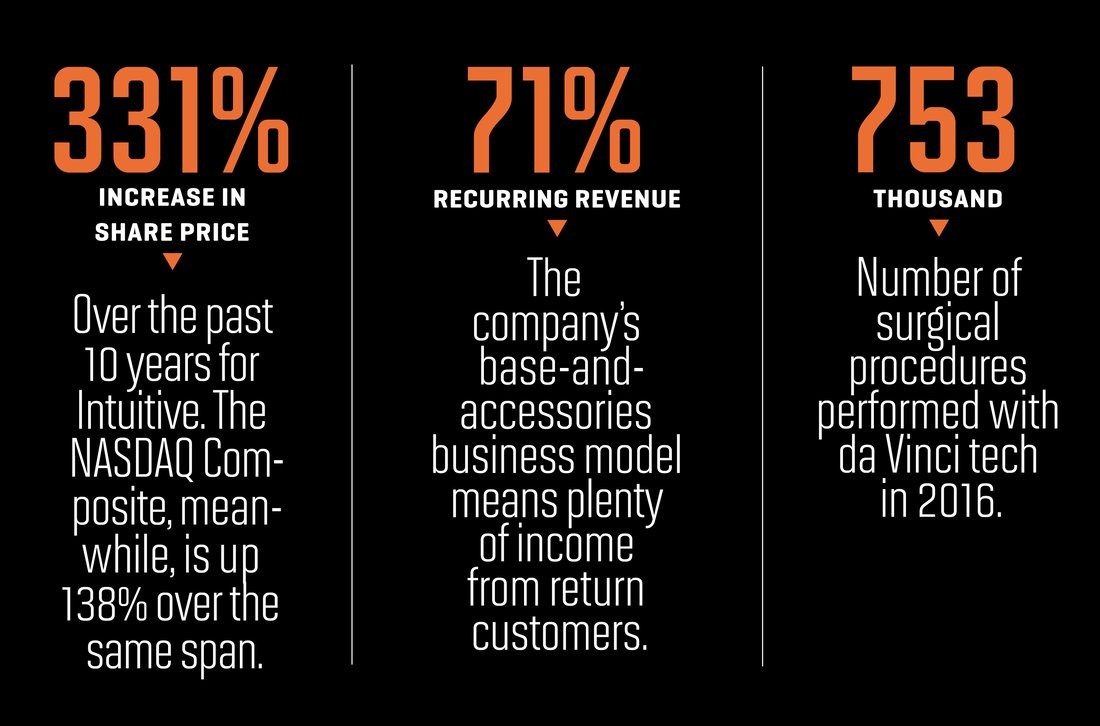 ?
?
|
蘇利文表示,雖然對(duì)于病人來(lái)說(shuō),是否接受機(jī)器人手術(shù),,對(duì)他們的醫(yī)保報(bào)銷沒有任何分別,,然而機(jī)器人手術(shù)無(wú)論對(duì)于病人還是對(duì)于醫(yī)院,都是具有成本優(yōu)勢(shì)的,?!昂芏嗳藳]有考慮過(guò),這項(xiàng)技術(shù)改變了病人的住院時(shí)間,。如果病人的住院時(shí)間從平均3.1天縮短到了2.1天,,那就節(jié)省了不少成本?!? 當(dāng)然,,每臺(tái)近200萬(wàn)美元的單價(jià),尤其對(duì)于一些對(duì)技術(shù)渴求度不高的市場(chǎng),,仍然不是一筆小數(shù)目,。雖然學(xué)界對(duì)于機(jī)器人手術(shù)對(duì)病人的效果還有爭(zhēng)議,但醫(yī)學(xué)界基本已經(jīng)認(rèn)同,,機(jī)器人輔助系統(tǒng)在執(zhí)行一些復(fù)雜度較高的手術(shù)時(shí)確實(shí)是有優(yōu)勢(shì)的——比如治療前列腺癌的前列腺切除術(shù),,這個(gè)手術(shù)要求精細(xì)地切除前列腺及其周邊組織。實(shí)踐也證明了達(dá)芬奇系統(tǒng)的功效:對(duì)于這種手術(shù),,機(jī)器人輔助手術(shù)確實(shí)既有益于患者,,也更加節(jié)省成本。 Intuitive公司目前的一項(xiàng)重要戰(zhàn)略,,就是不僅僅向潛在病人進(jìn)行宣傳,,更重要的是對(duì)年輕一代的外科醫(yī)生宣揚(yáng)機(jī)器人手術(shù)系統(tǒng)的優(yōu)點(diǎn),因?yàn)樗麄儾攀枪镜南乱淮脩簟? 摩根士丹利的分析師大衛(wèi)·劉易斯講了這樣一個(gè)故事,,充分說(shuō)明了外科學(xué)界的環(huán)境變化得有多快:就在五年前,,在一次腹腔鏡和內(nèi)窺鏡手術(shù)的專業(yè)會(huì)議上,“人們對(duì)Intuitive Surgical產(chǎn)品的接受度還很低,,基本上在每個(gè)會(huì)議室里,,你都能感受到,大多數(shù)醫(yī)生都不贊成使用這個(gè)系統(tǒng),?!比欢迥旰螅谕瑯拥臅?huì)議上,,年輕的外科醫(yī)生們已經(jīng)在展示他們使用Intuitive機(jī)器人系統(tǒng)的一些數(shù)據(jù)了,。 去年,投資和研究集團(tuán)RBC Capital進(jìn)行的一項(xiàng)調(diào)查發(fā)現(xiàn),,美國(guó)的外科醫(yī)生認(rèn)為,,未來(lái)五年,,35%的手術(shù)將有某種形式的機(jī)器人參與,而現(xiàn)在這一比例僅為15%,。 |
While insurance reimbursement rates for patients are the same, in most cases, whether they opt for robotic surgery or not, there is nonetheless a difference in cost, says Sullivan—to both the patient and the hospital. “What really is never factored in is the fact that you’re changing the patient’s length of stay,” he says. “In a hospital, if your average length of stay is 3.1 days and you take that down to 2.1, that is a real cost savings.” But when it comes to the question of how quickly Intuitive can ramp up sales, particularly in less tech-hungry markets, the machine’s nearly $2 million price tag is no small factor. And while the academic debate over patient outcomes is a heated one, a rough consensus does emerge when it comes to more complicated surgeries—such as radical prostatectomy, where the prostate gland and some of its surrounding tissue is removed, usually to treat prostate cancer. Here, the verdict is in da Vinci’s favor: Robotic surgery tends to be both better for the patient and more cost-effective.?? A big part of Intuitive’s playbook is to evangelize that message not just with potential hospital customers, but?—more important—with young surgeons who, the company hopes, will represent the next generation of its users. David Lewis, the Morgan Stanley analyst, shares an anecdote about just how quickly the surgical environment is changing. Five years ago, at a prominent meeting for laparoscopic and endoscopic surgeons, he says, “the reception to Intuitive Surgical was extremely poor. In fact you could sort of sense in any given room that physicians were almost frowned upon for their use of the system.” Five years later, that same meeting had been overtaken by young surgeons presenting data from their use of Intuitive robots. A survey by investment and research group RBC Capital last year found that American surgeons think that within five years, 35% of operations will involve robots in some form, compared with 15% today. |
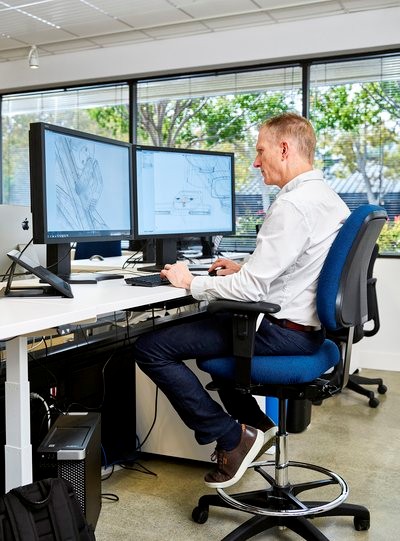
Intuitive Surgical的總部人員正在進(jìn)行規(guī)劃設(shè)計(jì)工作
照片:Spencer Lowell為《財(cái)富》拍攝?
|
市場(chǎng)的擴(kuò)大自然會(huì)帶來(lái)競(jìng)爭(zhēng),。過(guò)不了多久,美敦力公司和Verb Surgical公司(這是一個(gè)強(qiáng)生公司與谷歌母公司Alphabet的生命科學(xué)子公司Verily共同創(chuàng)辦的手術(shù)機(jī)器人項(xiàng)目)都將推出自己的競(jìng)爭(zhēng)產(chǎn)品,。這兩家公司的實(shí)力不容小覷,,他們?cè)谑澜绺鞯氐尼t(yī)院扎根很深,很有可能利用這些根深蒂固的關(guān)系,,將自己的設(shè)備賣進(jìn)手術(shù)室,。 不過(guò)華爾街著名投行Leerink的醫(yī)療產(chǎn)品與設(shè)備研究部總經(jīng)理理查德·紐維特卻對(duì)Intuitive公司的未來(lái)表示樂(lè)觀。他表示:“我們認(rèn)為,,競(jìng)爭(zhēng)是對(duì)市場(chǎng)的一種檢驗(yàn),,而且很可能會(huì)擴(kuò)大市場(chǎng)的規(guī)模?!? 摩根士丹利的劉易斯也認(rèn)同這種觀點(diǎn),。他認(rèn)為,Intuitive公司的發(fā)展會(huì)經(jīng)歷三個(gè)階段(不過(guò)他很快指出,,這是他個(gè)人的預(yù)測(cè),而不是Intuitive公司的預(yù)測(cè)),。第一階段已經(jīng)在進(jìn)行了,,就是要持續(xù)搶占美國(guó)、歐洲,、亞洲的更多醫(yī)院,。“歐洲的機(jī)器人市場(chǎng)從很多方面看,,至少落后美國(guó)三到五年,。所以將這些技術(shù)打入歐洲市場(chǎng),然后打入中國(guó)和日本等新市場(chǎng),,將是非常重要的,。” 接下來(lái)的兩個(gè)階段則更引人注目,,也蘊(yùn)藏著最大的潛在增長(zhǎng)機(jī)會(huì),。首先是“平臺(tái)擴(kuò)張”階段,Intuitive要推出一系列新品或啟動(dòng)一系列研發(fā),。其中之一就是第五代的“達(dá)芬奇X”,,它最近剛剛獲得了FDA的許可,售價(jià)預(yù)計(jì)將比Xi便宜60萬(wàn)美元,。它很可能會(huì)吸引那些不夠財(cái)大氣粗的醫(yī)療機(jī)構(gòu)的眼球,。 |
With an expanding market, naturally, comes competition. Both Medtronic and Verb Surgical (Johnson & Johnson’s joint robotic surgical project with Google parent Alphabet’s life sciences arm, Verily) are expected to challenge Intuitive with their own robotic surgery product lines. Those aren’t easy names to go up against; they have substantial footholds in hospitals around the world, and they may be able to leverage those long-standing relationships to elbow their devices into the OR. Richard Newitter, a managing director of the medical supplies and devices research unit at Leerink, is largely bullish on Intuitive’s future, however. “We think the competition is a validation of the market and potentially an expansion of it,” he says. Morgan Stanley’s Lewis agrees. He envisions three major phases of progression for Intuitive (though he’s quick to note that this is his prediction, not the company’s). The first phase, which is ongoing, is continuing to establish a presence in more hospitals in the U.S., Europe, and Asia. “European markets in many respects have lagged the U.S. robotic markets by three to five years if not longer,” says Lewis. “So taking these kinds of technologies into the European markets, and taking them into new markets like China and Japan, is going to be important.” But Lewis says the following two phases are more compelling—and where the greatest potential growth may emerge. First comes what he calls “platform expansion,” in which Intuitive pushes a number of new products that have either just entered the market or that are in the works. One is the da Vinci X, a system recently cleared by the FDA, which comes with a list price $600,000 cheaper than the Xi. Those units could attract hospitals that don’t have the deep pockets major cancer centers do. |
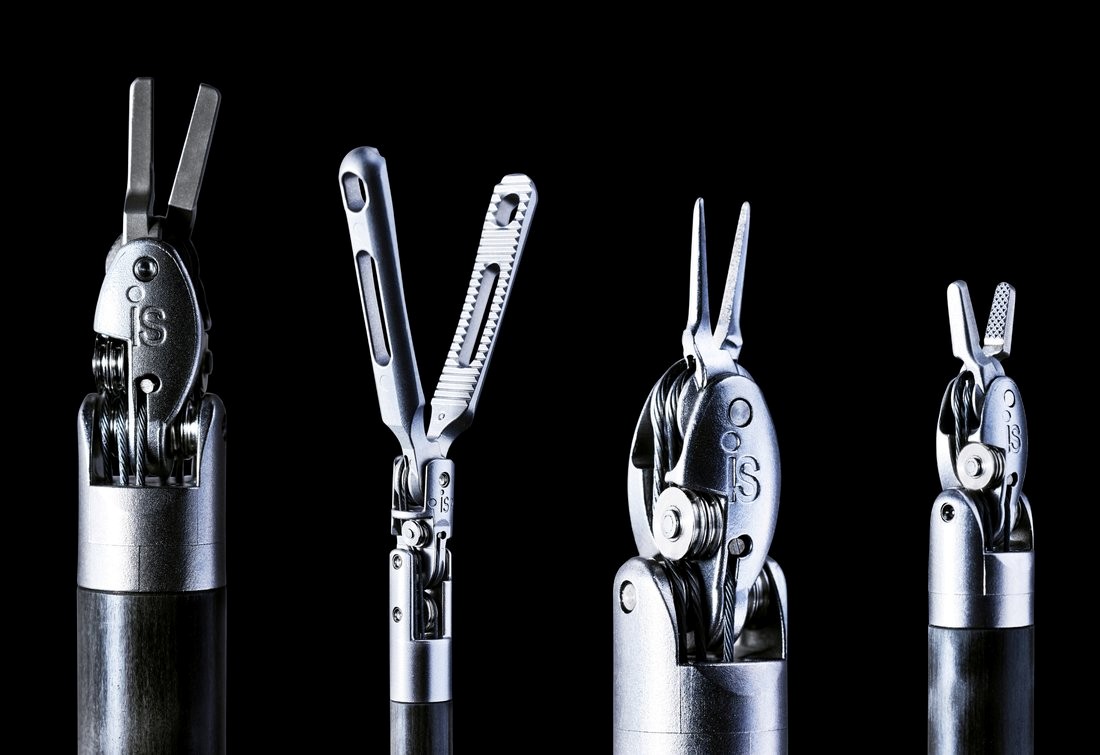
達(dá)芬奇系統(tǒng)的部分配件? 照片:Spencer Lowell為《財(cái)富》拍攝
|
另一個(gè)重磅產(chǎn)品則是預(yù)計(jì)于2018年推出的“達(dá)芬奇SP”,,劉易斯認(rèn)為它很有可能是一款改變游戲規(guī)則的產(chǎn)品。SP是“單孔”(Single Port)的縮寫,。與有好幾根機(jī)械臂的Xi不同,,達(dá)芬奇SP系統(tǒng)只有一根機(jī)械臂,所以它只需要通過(guò)一個(gè)小孔就能進(jìn)入人體,,然后再展開它的四種工具,。如果你看了它的演示視頻,你可能會(huì)覺得這是某種外星生物,。達(dá)芬奇SP大大提高了治療某些口腔癌癥的便利性,,因?yàn)樗梢酝ㄟ^(guò)口腔等人體的現(xiàn)有孔洞進(jìn)行手術(shù),從而減少了對(duì)患者的侵入創(chuàng)傷,。(而傳統(tǒng)手術(shù)方法有時(shí)要在病人頸部開刀,。)在今年五月的一份報(bào)告中,劉易斯等人估計(jì)道,,到2025年,,每年使用這種新型機(jī)器人系統(tǒng)進(jìn)行的手術(shù)或?qū)⒍噙_(dá)17萬(wàn)例。 接下來(lái)是第三階段,,即Intuitive公司有可能將各種各樣的類似技術(shù)整合到一個(gè)單一的平臺(tái),。劉易斯想象道,未來(lái)的機(jī)器人手術(shù)系統(tǒng)或?qū)碛懈冗M(jìn)的成像技術(shù),,能夠突出身體的更多細(xì)節(jié),,使外科醫(yī)生能夠立即區(qū)分不同的血管和神經(jīng)。另外,,有些機(jī)器人系統(tǒng)還應(yīng)該能直接在控制臺(tái)上顯示病人的病史,,或者可以在進(jìn)行當(dāng)前手術(shù)的同時(shí),用視頻回看病人之前的手術(shù)過(guò)程,。 這些可能聽起來(lái)像是科幻小說(shuō)里的情節(jié),,但就在短短10年前,機(jī)器人手術(shù)的理念不也還是科幻小說(shuō)里的構(gòu)思嗎,? 機(jī)器學(xué)習(xí):醫(yī)療保健領(lǐng)域的3大創(chuàng)新科技理念 近年來(lái),,許多醫(yī)療技術(shù)領(lǐng)域的創(chuàng)業(yè)者借鑒了一些科幻小說(shuō)里的情節(jié),并把它們變成了現(xiàn)實(shí),。 |
Another, which Lewis calls a potential game changer, is the da Vinci SP, expected to be released in 2018. “SP” stands for “single port.” Rather than the four, spiderlike arms of the da Vinci Xi, the da Vinci SP has just one arm, inserted into one hole in the body, through which four different maneuverable tools emerge. Watch a video of the machine in action and you will likely think it’s some alien creature. The SP, for instance, could enable surgeons to treat certain oral cancers far less invasively because the port can be inserted through an existing orifice such as the mouth. (By contrast, in some cases, traditional surgical approaches require splitting open a large portion of a patient’s neck.) In a May report, Lewis and colleagues estimated that, by 2025, surgeons could perform as many as 170,000 new robotic procedures annually using the instrument. Then comes phase three, according to the Morgan Stanley analyst: That’s where Intuitive could potentially bring together all sorts of buzzy technologies under a single platform, Lewis says. He imagines robotic systems with more advanced imaging that can highlight the body in even greater detail, enabling surgeons to instantly differentiate between individual blood vessels and nerves. Or those that incorporate a patient’s medical history right on the console. Or video that allows surgeons to replay past procedures during a current one. All of that may sound like the stuff of science fiction. But then, 10 years ago, so did the idea of a robot surgeon. Machine Learning: 3 Novel Tech Ideas in Health Care Medtech entrepreneurs are taking ideas from science-fiction novels and bringing them to life. |

|
Catalia Health:提醒你不要“吃錯(cuò)藥”的機(jī)器人伴侶,。 “吃錯(cuò)藥”這件事每年給社會(huì)帶來(lái)的代價(jià)高達(dá)3000億美金。但是有了這個(gè)可愛的黃色小機(jī)器人,,媽媽再也不用擔(dān)心我吃錯(cuò)藥了,。Catalia Health公司推出的Mabu機(jī)器人是一個(gè)由人工智能技術(shù)驅(qū)動(dòng)的機(jī)器人醫(yī)療伴侶,它不僅能與患者聊天解悶兒,,還能提醒他們按時(shí)吃藥,。 Hololens:用VR技術(shù)培訓(xùn)醫(yī)生,。 目前方興未艾的VR和AR技術(shù)不僅僅能用來(lái)打游戲。凱斯西儲(chǔ)大學(xué)和克里夫蘭醫(yī)學(xué)中心就正在使用微軟的Hololens教醫(yī)學(xué)生學(xué)習(xí)解剖學(xué),。利用VR全息技術(shù),,學(xué)生可以從各種角度操縱“器官”和“骨骼”,從而更加真實(shí)地看到人體內(nèi)部的情景,。 Woebot Labs:聊天機(jī)器人療法,。 如果你有心理問(wèn)題,又請(qǐng)不到(或者請(qǐng)不起)心理醫(yī)生,,不妨試試Woebot,。它是斯坦福大學(xué)研發(fā)的一個(gè)聊天機(jī)器人,在Facebook Messenger上就可以全天使用,。它會(huì)關(guān)心地詢問(wèn)你的感受,,建議你怎樣才能感覺好些,甚至偶爾講幾個(gè)笑話,。它也算是AI時(shí)代的談心療法了,。(財(cái)富中文網(wǎng)) 譯者:賈政景 ? 本文另載于2017年11月1日的《財(cái)富》雜志上。 |
Catalia Health: A robo-nag for your medications. What if a cute little yellow robot could help solve a $300 billion health care problem: people failing to properly take their prescription drugs? That’s what Catalia Health has set out to do with Mabu, an A.I.-driven robotic medical companion that makes small talk with patients—and gives them timely reminders to take their meds too. Hololens: Using VR to train MDs. Augmented and mixed reality aren’t just for gaming. Case Western Reserve University and the Cleveland Clinic are designing programs that use Microsoft’s HoloLens to teach med students anat?omy. With holograms, students can manipulate organs and bones from every conceivable angle and get an immersive look at the body’s internal landscape. Woebot Labs: Chatbot therapy. Couch optional For those who can’t get an appointment with their therapist (or can’t afford one), there’s an alternative. Woebot, a chatbot developed at Stanford, will work through your issues 24/7 via Facebook Messenger. It will ask how you’re feeling, recommend ways to feel better, and even share the occasional joke. Think of it as talk therapy for the A.I. age. ? A version of this article appears in the Nov. 1, 2017 issue of Fortune with the headline “Coming to an O.R. Near You.” |
-
熱讀文章
-
熱門視頻











